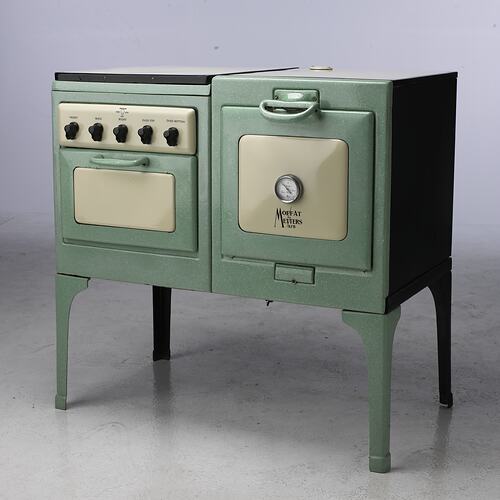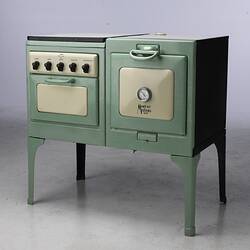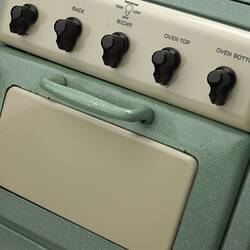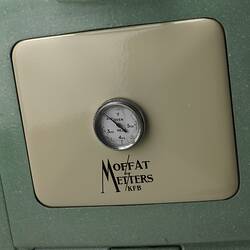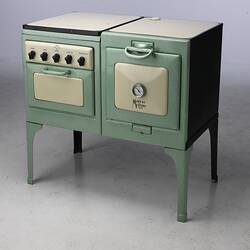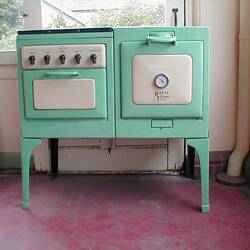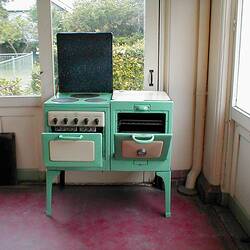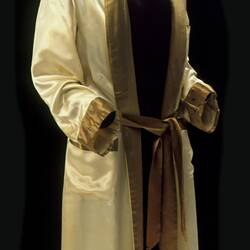Summary
Free-standing electric stove made by Metters KFB Pty. Ltd. in Footscray, Victoria, circa 1937. Around the late 1930s, the donor's mother, a wealthy Geelong housewife, purchased this electric stove. She already owned an electric refrigerator and mix-master. The modern wife of a successful businessman, the donor's mother represented the typical consumer of electrical goods at this time. In an era when most households were not yet wired for electricity and when electrical appliances were still a luxury, the new stove was apparently used only once or twice to bake scones, and was then abandoned in disappointment. According to family lore, not even the cook was allowed to use it. The stove sat dormant in the kitchen for over 40 years, alongside the faithful old gas stove it was meant to replace. When the stove came into the museum's collection, it was in almost new condition, a rare state for domestic appliances, which are generally marked by years of hard use.
Physical Description
A free-standing, electric, Fahrenheit stove in green and cream enamel. The horizontal body on 4 legs comprises 2 ovens and a hob. TOP: 2 sections, cream enamel with black trim. Left: hinged at back, covers hob. Right: grill vent back left corner, forms top of oven compartment. FRONT: 2 sections. Left: cream panel with control switches above small warmer-oven drawer. DOOR: green enamel border set with rectangular panel of cream. HANDLE - horizontal D-shape at top of door. Right: large oven. DOOR: green enamel border set with square panel of cream. Hinged along bottom. Middle of door temperature gauge. Manufacturer and model stencilled lower centre. HANDLE - hinged, horizontal D-shape, locked into catch on unit. INTERIOR: Left: warmer-oven drawer, lined with black enamel. Row of fuses at top; glass set within grey boxes. Hand writing below each fuse. Right: mottled black enamel. 13 runners. 2 removable wire shelves; 1 removable wire shelf with solid metal panel attached; 1 solid metal shelf; 1 mottled black enamel shallow baking tray. SIDES: Left: black panel. Right centre, 3 prong socket above 2 switches. Metal disk applied lower right. BACK: 2 sections, black panels. Left: solid panel. Right: 2 air grills upper left and right. Lower left, electrical cable.
Significance
This Metters-Moffat electric stove was purchased by the donor's mother-in- law, Alys Hearne, around 1937. Alys Hearne was a modern woman of means who was an early adopter of domestic technology. She already owned an early fridge and a mix-master and decided to update her gas stove with a new top- of-the-range electric stove. Alys was married to Oswald Charles Hearne who was a very wealthy business- man. He was also Mayor of Geelong three times. The family business produced and sold cough medicine products known as Hearne's Bronchitis Cure. The most popular product was the No. 7 mixture which contained morphine. The Hearnes lived in a large mansion on the Geelong waterfront at 53 The Esplanade North Geelong and had 2 servants: a cook and a housemaid. Because she had a cook Alys Hearne never cooked meals herself but did like to bake scones for pleasure. Apparently her first round of scones baked in the new electric stove did not work out, possibly because she was not used to baking with an electric heat source. After this Alys decided never to use the electric stove again and would not even allow her cook to use it. Mrs. Hearne's refusal to use this expensive new appliance was described by her son-in-law as extravagant. This could be seen as particularly so in the 1930s depression era when even a basic electric appliance was a real luxury for many. The abandoned electric stove stood, unused, side by side with the gas stove in the Hearne's kitchen for over 40 years until the early 1980s when it was used one last time. The Hearne's daughter and her husband (the donor) were by then the occupants of the house and were hosting a party there. The caterers needed more cooking appliances and even though the stove had not been used since the 1930s it was switched on and worked perfectly. In the mid 1980s the kitchen was remodelled and the stove was removed and placed in storage at the Hearne's house where it sat until December 2001 when the donor sold the house and moved out.
This 1937 stove marks an early moment in the first wave of consumerism in Australia, which began booming in the post World War II era, and which was directed toward the kitchen. Electrical appliances were heavily marketed to the home user from the 1920s, using advertising that claimed electricity would eradicate the drudgery of house-work, especially in a time when servants were becoming hard to find, and was more hygienic. Marketing also pushed the notion of modernism, especially in the 1930s, and tried to persuade the homeowner to be 'up to date' and stylish. there was a glamorisation of the housewife at this time, and the success of this marketing is reflected in the fact that women were the main buyers of electrical appliances, particularly young newly wed women.
The adoption of electrical appliances was relatively slow because homeowners needed to be in a position to afford to have their house wired for electricity and to purchase the early domestic appliances, all of which was quite expensive. By the end of WW2, however, there was a shift in expectation and access to electrical appliances. In 1944 the Commonwealth Housing Commission stated that 'all future homes should have a radio and fridge as basic equipment.' By 1947 more than 80% of homes in Victoria had been wired for electricity, which facilitated an increased use of electrical appliances at this time. Most larger appliances, however, didn't appear in the majority of homes until the 1950s.
The original owner of this stove bought into the consumer dream early - during the 1930s depression, and before World War 2 and the increase in manufacture that followed the war. Her wealth meant that her house was wired for electricity early on, and she could afford to purchase expensive consumer products.
The recipe booklets that were supplied with the stove clearly illustrate how organisations such as the SEC of Victoria were promoting electrical appliances at this critical stage in the adoption of electricity. They also indicate the education required for those using the new power source.
More Information
-
Collecting Areas
-
Acquisition Information
Donation from Mr Alan Glover, 13 Dec 2001
-
Manufacturer
Metters - KFB Pty Ltd, Footscray, Greater Melbourne, Victoria, Australia, circa 1937
-
Inscriptions
FRONT: panel on left, stencilled upper centre "MEDIUM/ HIGH (downward arrow) LOW/ OFF" Above each switch from left "FRONT BACK RIGHT OVEN TOP OVEN BOTTOM". Below each switch "OFF". DOOR: stencil "MOFFAT/ by/ METTERS/ KFB". INTERIOR: LEFT: below fuses from left to right "PLUG"; "L.H.TOP"; BACK TOP"; R.H.TOP"; "OVENTOP"; "OVEN BOTTOM"; "WARMER & OVEN". SIDE: on metal disk "MADE IN AUSTRALIA/ MOFFATS RANGE/ MANUFACTURED FOR/ STATE ELECTRICITY COMMISSION OF VICTORIA/ BY/ METTERS KFB PTY. LTD./ FOOTSCRAY, VIC./ STYLE M31/ SERIAL 7896/ VOLTS 230/ AMPS 34".
-
Brand Names
-
Classification
-
Category
-
Discipline
-
Type of item
-
Overall Dimensions
60 cm (Length), 95 cm (Width), 94 cm (Height)
-
References
HEARN, William Goodall. Hearne's Medicines [drop title]. Geelong, W.G. Hearn, Chemist, n.d. but circa 1880s - 1890s
-
Keywords
Consumerism, Cooking, Electricity, Household Appliances, Industrial Design
